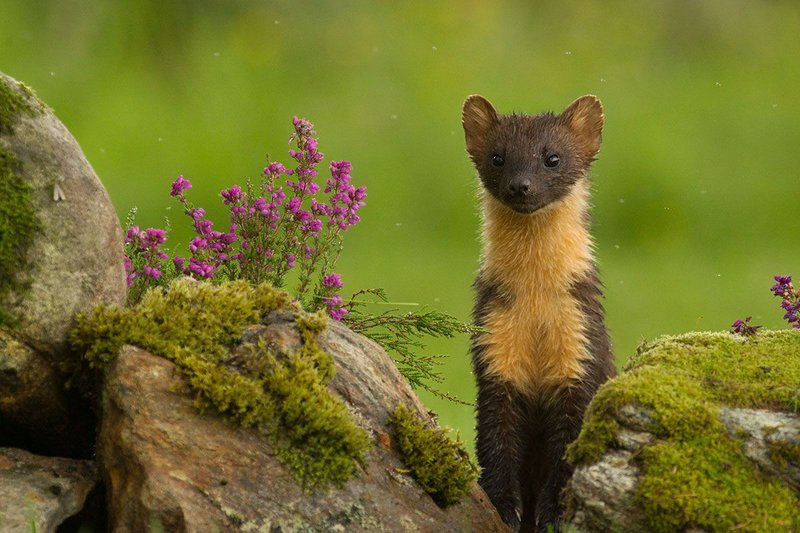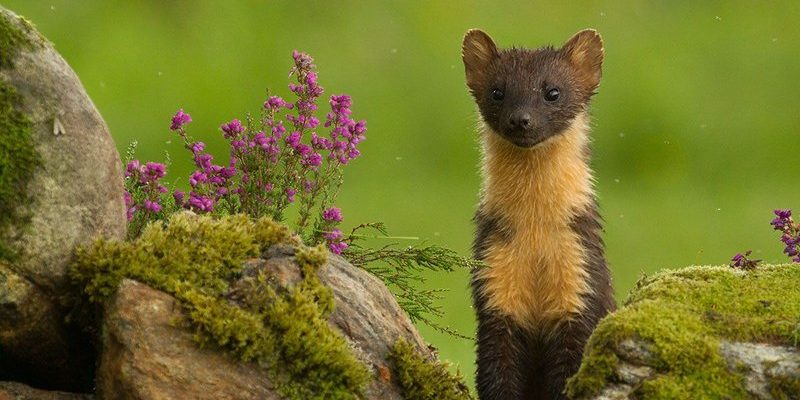
The European Pine Marten might just be one of those critters you’ve heard of but never really thought much about. Picture a small, agile creature, dashing through the trees with an elegance that would make a squirrel envious. It’s not just its good looks that make the pine marten fascinating; it’s also its clever hunting skills and unique lifestyle. If you’ve ever thought about what makes these animals tick, you’re in for a treat. Let’s dive into the world of the European Pine Marten.
These nimble little mammals belong to the mustelid family, which is a group that includes weasels, otters, and ferrets. That might sound a little technical, but it helps to know that they’re related to some very interesting animals. The European Pine Marten has a distinctive appearance, with a sleek body, bushy tail, and striking yellowish-brown fur. They’re not just pretty faces, though; they play a crucial role in their ecosystems. Understanding the European Pine Marten’s behavior, habitat, and diet can help us appreciate these beautiful creatures even more.
Physical Characteristics
The European Pine Marten is a sight to behold. Adults typically measure between 18 to 28 inches long, excluding the tail, which adds another 10 to 15 inches! They usually weigh around 5 to 10 pounds, making them relatively small compared to other mammals. With their slender bodies and agile limbs, they are built for life in the trees. The fur is a rich, golden-brown color, which can vary slightly depending on the region. Their throat and chest are often lighter, almost creamy, which adds to their charm.
One of the most remarkable features of the pine marten is its bushy tail, which not only helps with balance as they scamper through branches but also acts as a warm blanket in chilly weather. The facial structure is equally captivating, with bright eyes that can see well in low-light conditions—perfect for their mostly nocturnal lifestyle. They have sharp, retractable claws that allow them to climb trees with ease, a skill they often showcase when escaping predators or hunting prey.
Habitat and Distribution
The European Pine Marten prefers to dwell in woodland areas, particularly in regions with a mix of coniferous and deciduous trees. They are often found in forests across Europe, from the UK to Scandinavia, and even parts of Eastern Europe. They love high, dense canopies, as this helps them stay hidden from both predators and unsuspecting prey. You might be surprised to know that they’re quite adaptable and can also live in urban areas, as long as there’s enough greenery around.
Despite their broad distribution, pine martens tend to favor locations away from human activity. They create sprawling territories, usually between 2 to 10 square kilometers depending on the availability of food and shelter. Within these territories, you’ll find cozy dens often made in tree hollows, abandoned burrows, or even rock crevices. Their affinity for solitude means you’ll rarely spot more than one at a time, adding to their mysterious charm.
Diet and Hunting Behavior
What do you think a European Pine Marten eats? Well, they are omnivorous, which means their diet is quite diverse. They primarily feed on small mammals like voles and rabbits, but they also enjoy birds, eggs, insects, and even fruits and nuts when the mood strikes. This varied diet not only helps them survive but also makes them important players in their ecosystem by controlling small mammal populations.
When it comes to hunting, pine martens are skilled predators. They typically hunt at night (making them nocturnal) and use their keen sense of smell and eyesight to locate prey. Once they spot their dinner, they rely on stealth and agility to pounce. Often, they’ll climb trees to get a better vantage point. This hunting style is a lot like a game of hide-and-seek, where patience and cunning come into play. They might even cache food for later, burying it under leaves or snow to keep it safe from scavengers.
Reproduction and Lifespan
The mating season for European Pine Martens occurs between July and September. After a gestation period of about 240 days, females typically give birth to 2 to 5 kits in April or May. These little ones are born blind and helpless, relying entirely on their mother for care during their early weeks. As they grow, they start to explore their surroundings, learning vital skills from their mother about hunting, climbing, and survival.
Young pine martens stay with their mother for about 5 to 6 months before venturing out to establish their own territories. In the wild, they can live up to 7-10 years, but when conditions are right, some may even reach their teens. Isn’t it fascinating to think about how these small creatures navigate their world and develop their independent lives?
Conservation Status
Currently, the European Pine Marten is categorized as “Least Concern” by the IUCN. However, their populations have faced threats in the past, primarily due to habitat destruction and hunting. In some regions, they were heavily hunted for their fur, leading to significant declines in their numbers. Thankfully, conservation efforts, habitat protection, and public awareness campaigns have helped their populations stabilize in recent years.
It’s important to protect these animals and their habitats because they help maintain the balance in the ecosystems they inhabit. By preserving forests and natural areas, we ensure that pine martens—and many other species—can thrive. Whether you’re a nature enthusiast, a casual observer, or someone who just enjoys learning about wildlife, supporting conservation initiatives is a way to give these fantastic creatures a chance to flourish.
Interesting Facts
| Scientific Name: | Martes martes |
| Size: | 18-28 inches (body), 10-15 inches (tail) |
| Weight: | 5-10 pounds |
| Lifespan: | 7-10 years in the wild |
| Diet: | Omnivorous; feeds on small mammals, birds, insects, fruits |
| Habitat: | Woodlands, forests, urban areas with greenery |
| Activity Level: | Nocturnal |
Behavior and Social Structure
When you think of the European Pine Marten, you might picture a solitary creature, and you’d be right. Pine martens are generally known to be solitary animals, only coming together during mating season. Their elusive nature means they prefer to keep to themselves, often marking their territory with scent markings and vocalizations. This is a clear indication of boundaries, helping to avoid conflicts with other martens.
Their behavioral patterns can be quite interesting too. Pine martens are not just cunning hunters; they also engage in playful activities. Young ones particularly enjoy climbing and wrestling, using their environment as a playground. Watching them interact can be quite charming, as they showcase different aspects of their personalities, from playful to serious. You might even find them enhancing their agility by simply bouncing around in the branches!
Human Interaction
Many people are unaware of the European Pine Marten’s existence, yet they are slowly becoming part of our cultural identity. In certain areas of Europe, these charming creatures have become symbols of forest health. They are often seen as indicators of how well a forest ecosystem is functioning. A healthy population of pine martens usually suggests a rich biodiversity, which is a good sign for the wildlife around them.
However, they do face challenges due to urban expansion and habitat loss. As humans encroach on their territories, pine martens find it increasingly difficult to thrive. It’s a classic example of the push and pull between development and conservation. But communities are getting more involved in understanding and preserving these precious creatures, ensuring that future generations can also enjoy the beauty of the European Pine Marten.
FAQ
What is the habitat preference of the European Pine Marten?
The European Pine Marten prefers wooded areas, especially forests that combine both coniferous and deciduous trees. They thrive in environments where they can easily climb and find food while staying hidden from potential predators. Although they typically avoid areas with heavy human activity, they can adapt to urban settings if sufficient greenery is available.
Are European Pine Martens endangered?
Fortunately, the European Pine Marten is currently classified as “Least Concern” by the IUCN. However, they have experienced declines in certain areas due to habitat loss and historical hunting practices. Conservation efforts are underway to maintain and support their populations, ensuring these creatures can continue to thrive in the wild.
How long do European Pine Martens live?
In the wild, European Pine Martens can live between 7 to 10 years. However, in ideal conditions with fewer threats from predators, they may live into their teenage years. These remarkable creatures lead solitary lives and are able to navigate the challenges of their environment effectively, contributing to their survival.
What do European Pine Martens eat?
European Pine Martens are omnivorous, feeding on a variety of foods. Their primary diet includes small mammals like voles and rabbits but also consists of birds, eggs, insects, and seasonal fruits and nuts. This adaptability in their diet not only helps them thrive in their environments but also maintains the balance of the ecosystems they inhabit.
Do European Pine Martens interact socially?
Generally, European Pine Martens are solitary animals, coming together primarily during mating season. They establish territories and mark them with scents to avoid conflicts. However, young martens do engage in playful behaviors, especially among siblings, showcasing a bit of sociability before becoming independent.
Can you find European Pine Martens in urban areas?
Yes, European Pine Martens can adapt to urban environments, provided there are green spaces available for them. They are known to roam in wooded areas close to urban settings, making them a unique example of wildlife coexisting with human development. However, their survival often depends on the availability of food and shelter in these settings.
What threats do European Pine Martens face?
The main threats to European Pine Martens come from habitat loss, hunting, and vehicle collisions. Urbanization can lead to reduced habitats, which affects their ability to find food and establish territories. Conservation efforts aim to mitigate these threats by protecting natural habitats and raising awareness about their importance in ecosystems.
Are there any common misconceptions about European Pine Martens?
One common misconception is that European Pine Martens are highly aggressive animals. While they can be territorial, they primarily avoid confrontations and prefer not to engage unless necessary. They are generally more curious and elusive than confrontational, which can lead to misinterpretation of their behavior.
How can we help protect European Pine Martens?
There are several ways you can help protect European Pine Martens. Supporting conservation initiatives, spreading awareness about their importance in ecosystems, and participating in habitat restoration projects are all great starting points. Additionally, reducing urban expansion into natural forested areas can safeguard their habitats for generations to come.
How do European Pine Martens contribute to their ecosystems?
European Pine Martens play a vital role in their ecosystems by helping control populations of small mammals and birds. Their hunting activities help maintain the balance between different species, preventing overpopulation of certain animals. By being a part of the food chain, they contribute to the overall health and biodiversity of their habitats.
What do baby European Pine Martens look like?
Baby European Pine Martens, or kits, are born blind and helpless, with soft, fluffy fur. They begin to develop their distinctive features as they grow, gaining their full coloration over the first few months of life. These kits rely entirely on their mother during their early weeks, learning essential survival skills before venturing out on their own.

